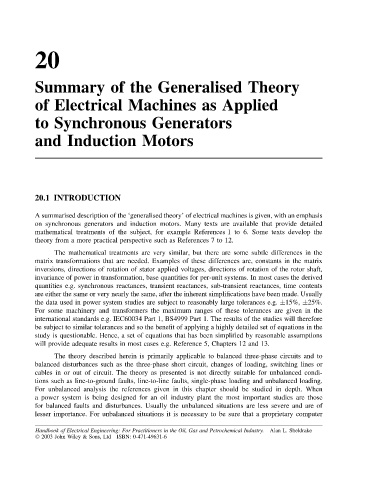Page 489 - Handbook of Electrical Engineering
P. 489
20
Summary of the Generalised Theory
of Electrical Machines as Applied
to Synchronous Generators
and Induction Motors
20.1 INTRODUCTION
A summarised description of the ‘generalised theory’ of electrical machines is given, with an emphasis
on synchronous generators and induction motors. Many texts are available that provide detailed
mathematical treatments of the subject, for example References 1 to 6. Some texts develop the
theory from a more practical perspective such as References 7 to 12.
The mathematical treatments are very similar, but there are some subtle differences in the
matrix transformations that are needed. Examples of these differences are, constants in the matrix
inversions, directions of rotation of stator applied voltages, directions of rotation of the rotor shaft,
invariance of power in transformation, base quantities for per-unit systems. In most cases the derived
quantities e.g. synchronous reactances, transient reactances, sub-transient reactances, time contents
are either the same or very nearly the same, after the inherent simplifications have been made. Usually
the data used in power system studies are subject to reasonably large tolerances e.g. ±15%, ±25%.
For some machinery and transformers the maximum ranges of these tolerances are given in the
international standards e.g. IEC60034 Part 1, BS4999 Part 1. The results of the studies will therefore
be subject to similar tolerances and so the benefit of applying a highly detailed set of equations in the
study is questionable. Hence, a set of equations that has been simplified by reasonable assumptions
will provide adequate results in most cases e.g. Reference 5, Chapters 12 and 13.
The theory described herein is primarily applicable to balanced three-phase circuits and to
balanced disturbances such as the three-phase short circuit, changes of loading, switching lines or
cables in or out of circuit. The theory as presented is not directly suitable for unbalanced condi-
tions such as line-to-ground faults, line-to-line faults, single-phase loading and unbalanced loading.
For unbalanced analysis the references given in this chapter should be studied in depth. When
a power system is being designed for an oil industry plant the most important studies are those
for balanced faults and disturbances. Usually the unbalanced situations are less severe and are of
lesser importance. For unbalanced situations it is necessary to be sure that a proprietary computer
Handbook of Electrical Engineering: For Practitioners in the Oil, Gas and Petrochemical Industry. Alan L. Sheldrake
2003 John Wiley & Sons, Ltd ISBN: 0-471-49631-6

